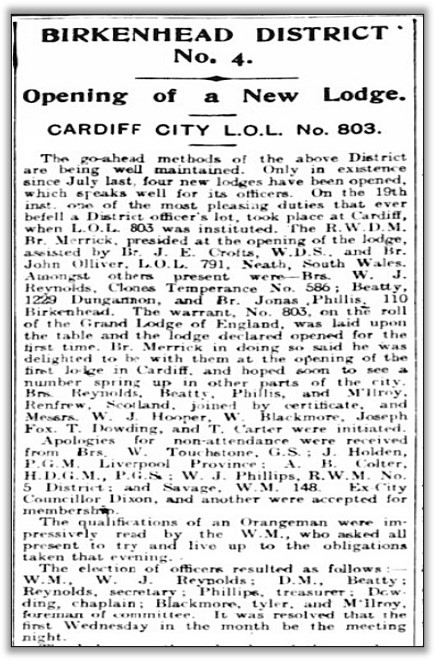Cardiff Orange History
The earliest connection of Orangeism to Wales goes back to 1798, and Welsh Regiments sent to Ireland to suppress the rebellion of the Society of United Irishmen. They returned to Great Britain with military or marching warrants. This was only three years after the Orange Institution was formed in Loughgall in 1795.
The first mention of Cardiff Orangeism which research has uncovered, is from The Cambrian Newspaper from 18th October 1834. It refers to the Grand Festival of Aberdare Loyal Orange Lodge number 335, being held at the Black Lion Inn. It reads ‘after the arrival of an immense number of Brethren from Merthyr, Newbridge and Cardiff Lodges’ – the Brethren then processed to church and afterwards to dinner, at which loyal speeches were made.
At this point any Lodges would have been under the governance of the Loyal Orange Institution of Great Britain.
Several times, during the 1800’s Cardiff Orangemen are mentioned again, however the main epicentre of Orangeism at this point was not the city, but was Aberdare and the Valleys’ mining communities. For nearly thirty years Aberdare had it’s own District Lodge, with four Male and four Female Lodges included.
Throughout the 1880’s and 90’s there were calls at various times from influential Cardiff people, in support of an Orange Lodge to be established in Cardiff. One of those voices was the Reverend Alexander Roger of Trinity Parsonage, Cardiff.
Cardiff City L.O.L. 803
In 1907, Birkenhead District Lodge number 4 unveiled a plan to establish four new Orange Lodges in South Wales. Two of these Lodges were to be opened in Cardiff, one in the city centre and the second in the northern outskirts of the city. Cardiff City L.O.L. 803 and Pentrych L.O.L. 809 were the Lodges, and both were active for years.
Cardiff City L.O.L. 803 was formed on the 19th April 1907 in the Grangetown part of the city and was connected to St Paul’s Anglican church.
The Lodge initially held their meetings in the Iron Rooms in Broomsgrove Street and the first Worshipful Master was Brother W. J. Reynolds.
Membership grew rapidly and inside two years had more than doubled its numbers. Regular social events and dances were held by LOL 803.
Throughout the following years, the Lodge moved home, firstly to St Andrew’s Parish Hall on the Wyeverene Road and then to the Maendy Brickworks.
During the Great War several members of the Lodge served and at least one member died at sea. The Lodge survived until 1921, when it was last recorded on the Grand Lodge of England’s records. Many Lodges folded as a result of World War One, as people struggled with faith and what they had encountered.
Rawlins White Memorial L.O.L. 803
In 2012, Brethren living in Cardiff who were members of The Somme Memorial L.O.L. 842 of Bristol, determined to start a Lodge in Cardiff. Approval was granted at all levels within the Institution, and the Grand Lodge of England gave permission to use the old Cardiff City warrant number 803, so maintaining a link with the previous Cardiff Lodge. (Click here to read about the Opening Day)
On Saint Patrick’s Day 2012, Rawlins White Memorial Loyal Orange Lodge number 803 of Cardiff was formed. The Lodge took it’s name from Rawlins White, the Protestant martyr, burnt at the stake in central Cardiff on 30th March 1555, during the reign of ‘Bloody Queen Mary’. The Lodge is part of the Plymouth District Lodge and the Metropolitan Province of the Grand Orange Lodge of England.
On that opening day, 83 members of the Institution gathered in the Cardiff Lodge room – every region of the British Isles was represented, including the Republic of Ireland.
The first Worshipful Master was Brother Stuart Mullaney who was succeeded in 2022 by Brother Joe Stevenson.
The lodge continues to thrive and grow, and since formation has more than tripled its membership. The colours have been raised on parades in Cardiff, Bristol, Brixham, Burnley, Liverpool, London, Glasgow and at many venues in Northern Ireland.
The Lodge has a wide spread of members from all four regions of the United Kingdom and currently approximately 30% of the membership are Welshmen.
We have completed a research project on the History of Welsh Orangeism since 1798 using information from Grand Lodge records, the National Library of Wales and the British Newspaper Archive. It has unveiled a much greater presence of Orangeism within the Principality than we realised, with upwards of 20 Lodges down through the years, and District Lodges both in North and South Wales. The history will soon be available as a Youtube video.






